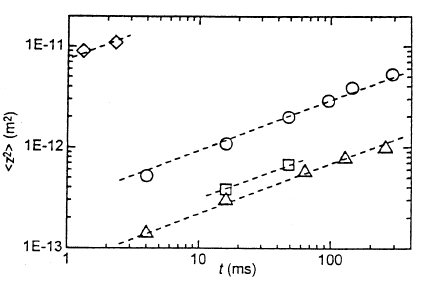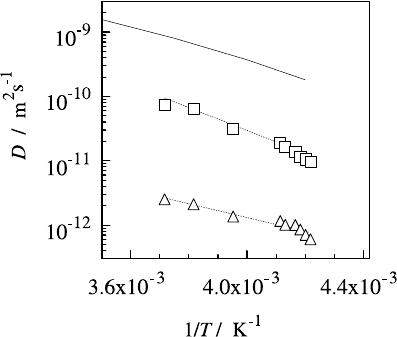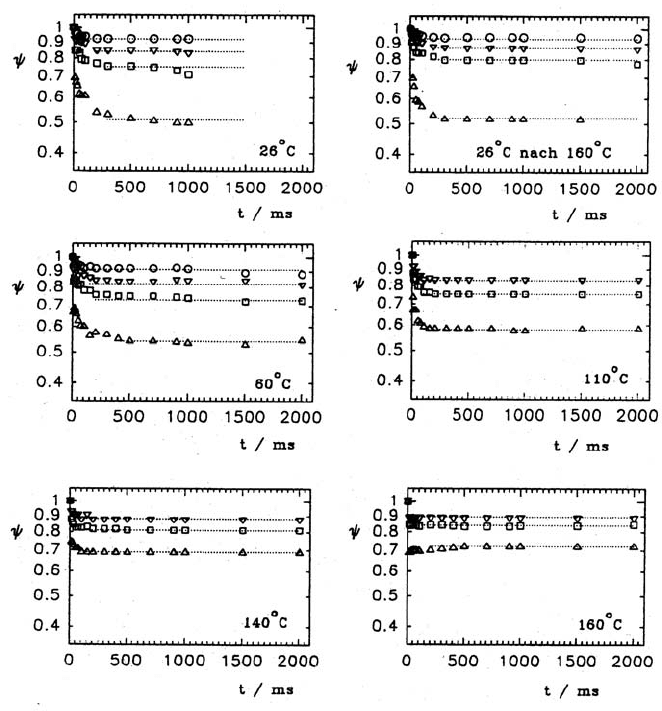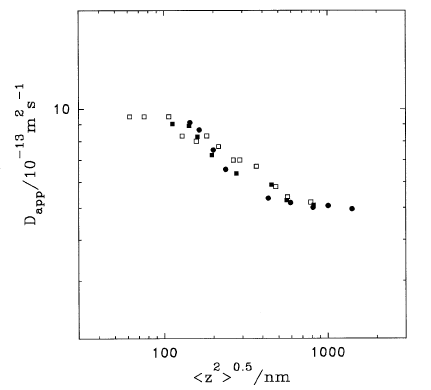Heitjans P., Karger J. (Eds.). Diffusion in Condensed Matter: Methods, Materials, Models
Подождите немного. Документ загружается.


10 PFG NMR Studies of Anomalous Diffusion 435
the assumption that molecular diffusion proceeds by stochastic jumps be-
tween adjacent adsorption sites of separation λ with a mean time τ between
subsequent jump attempts. Jump attempts are only successful if the sites
where the jumps are directed to are unoccupied. The occupation probability
is denoted by θ. It could be shown by MD simulations [49] that the validity of
(10.27) and (10.28) is not confined to the case of activated jumps but holds
quite generally if the quantity θ is understood as a suitably defined pore-
filling factor. Moreover, it could be shown [50] that as in the case of normal
diffusion the propagator is given by a Gaussian, albeit with a mean square
displacement increasing in proportion to the square root of the observation
time (cf. (10.27)) rather than with the observation time itself (cf. (10.8)).
By use of the PFG NMR technique, zeolites with one-dimensional chan-
nels served as the first model systems where the validity of (10.27) could
be demonstrated experimentally [51–54]. As an example, Fig. 10.7 shows the
molecular mean square displacement of CF
4
in AlPO
4
-5 at 180 K as a func-
tion of the observation time for different concentrations. At least for the
larger concentrations, the validity of (10.27) could be confirmed over up to
two orders of magnitude of the observation time. The displacement z(t)ofa
molecule in a single-file system may be shown to be correlated to the displace-
ment s(t) of the same molecule without any neighbours (i.e. of an isolated
molecule) by the equation [55, 56]
z
2
(t) = l |s(t)| , (10.29)
where l denotes the mean free distance (clearance) between adjacent mole-
cules in the single-file system.
Table 10.1 summarizes the values for F taken from Fig. 10.7, together
with the values for the mean free distance l calculated from the sorbate
Fig. 10.7. Molecular mean square displacement of CF
4
in AlPO
4
-5 at 180 K as a
function of the observation time at sorbate concentrations of 0.005 (3), 0.05 (
),
0.2 (2), and 0.4 () molecules per unit cell, respectively [54].

436 J¨org K¨arger and Frank Stallmach
Table 10.1. Results of the PFG NMR self-diffusion studies with CF
4
adsorbed in
AlPO
4
-5 at 180 K, represented in terms of the single-file mobility factor F and the
limiting diffusivity. The errors of the experimental values are about 50%.
clFD
(mol./unit cell) (nm) (m
2
s
−1/2
)(m
2
s
−1
)
0.4 1.63 0.7 · 10
−12
0.6 · 10
−6
0.2 3.73 1.5 · 10
−12
0.5 · 10
−6
0.05 16.3 4.5 · 10
−12
0.3 · 10
−6
0.005 167 1.0 · 10
−10
1.1 · 10
−6
concentration c and the diffusivities D, which an isolated molecule in the
channel would have. The latter quantity follows from (10.29) by using the
expression
|s(t)| =
&
4D
π
√
t, (10.30)
which may be easily derived from the propagator for normal diffusion (cf.
(10.6) and (10.8)). The estimated single-particle diffusivities are found to
be by two orders of magnitude larger than the largest diffusivities so far
observed in zeolitic adsorbate-adsorbent systems [3]. In contrast to the three-
dimensional pore network of “ordinary” zeolites, in one-dimensional channels
the molecular momentum is preserved over much longer time intervals, so
that the large values for the single-particle diffusivities are not unexpected.
The direct measurement of such diffusivities by PFG NMR is excluded due
to the extremely low concentration, which the diffusants should have in such
experiments.
For practical applications, one has to take account of the finite size of the
zeolite crystallites of single-file type. While under non-equilibrium conditions
– i.e. during molecular adsorption or desorption – finite single-file systems do
not exhibit any peculiarities in comparison with the case of ordinary diffusion
[48,57,58], tracer exchange and chemical reactions are found to be controlled
by the single-file confinement. Since any arbitrarily chosen pair of molecules
in single-file systems cannot be completely uncorrelated in its movement the
boundary conditions relevant for finite single-file systems affect the transport
behaviour of all individual diffusants in the single-file system. The influence
of the boundary conditions on single-file diffusion is far from being solved,
and recent theoretical studies [59–63] try to handle the difficulties arising
from these complications.
As a consequence of the finite extension of real single-file systems, parti-
cle displacements within the file are subjected to a second mechanism, which
is caused by the particle exchange between the marginal sites and the sur-
10 PFG NMR Studies of Anomalous Diffusion 437
rounding atmosphere. Since subsequent events of molecular adsorption and
desorption on the marginal sites may occur independently from each other,
the associated shifts of the particles in the file are also independent from
each other. The corresponding molecular displacements are therefore subject
to normal rather than to anomalous diffusion. As a consequence, with in-
creasing observation time molecular displacements are very soon dominated
by this second mechanism. The ratio between the corresponding diffusivity
and the diffusivity of a sole (i.e. isolated) molecule in the file is of the order of
the reciprocal value of the site number [60, 64]. Molecular exchange between
single-file systems and the surrounding atmosphere is therefore dramatically
slowed down in comparison with adsorbents undergoing normal diffusion.
In [65] this mechanism has been identified as the key process for ensuring
reactivity enhancement by “molecular traffic control” [66]. Reactivity en-
hancement by “molecular traffic control” has been postulated to occur if the
reactant and product molecules enter and leave pore networks along different
diffusion paths. The possibility of substantial differences in the accessibility
of different ranges of the intracrystalline pore system by the different com-
ponents in multi-component adsorbate-adsorbent systems has been recently
demonstrated by MD simulations [67]. If the involved molecules are accom-
modated by different channels, reactant molecules will enter and product
molecules will leave the catalysts along separated channels, i.e. without be-
ing inhibited by the presence of the other component. Microscopically, this
situation appears in the existence of overall concentration gradients along
both channel types, viz. into the catalyst particle for the reactant and out
of the catalyst particle for the product molecules. From the above considera-
tions it is well known that under such conditions, i.e. under the existence of
macroscopic concentration gradients, there is no additional transport inhibi-
tion due to the single-file effects. In the conventional case, i.e. for coinciding
accommodation probabilities of the two components, however, the overall
concentration is constant over the total channel network, so that molecular
displacements within the system are subject to the additional transport in-
hibition of single-file confinement [68]. Obviously, reactivity enhancement by
molecular traffic control is based on the suppression of this inhibition mecha-
nism by caring for different accommodation probabilities of the reactant and
product molecules in the two channel systems [69, 70].
10.4.6 Diffusion in Ordered Mesoporous Materials
The propagation rate of guest molecules in porous materials depends strongly
on the pore structure of the host system. As a consequence, measurement
of intraparticle diffusion is able to provide information about structural fea-
tures, which are not easily accessible by conventional techniques of structural
analysis such as scattering and diffraction methods. This is in particular true
for structural effects such as pore blockages and leakages in pore walls. As
an example, investigations of this type have substantially contributed to an

438 J¨org K¨arger and Frank Stallmach
Fig. 10.8. Dependence of the parallel (2) and perpendicular ()componentsof
the axisymmetrical self-diffusion tensor on the inverse temperature for water in
MCM-41 as measured at 10 ms observation time with PFG NMR. The dotted lines
maybeusedasaguidefortheeyes.Forcomparison,thefulllinerepresentsthe
self-diffusion coefficients of super-cooled bulk liquid water [74].
improvement of the understanding of the real structure of mesoporous ma-
terials of the MCM-41 type. In comparison with zeolites, diffusion measure-
ments with this type of material are complicated by the polydispersity of
the sample. As a consequence of the irregular shape of the adsorbent parti-
cles, which is quite common for mesoporous materials, analysis of transient
adsorption/desorption measurements is not free from some ambiguity. Be-
ing sensitive to molecular shifts within the individual adsorbent particles,
PFG NMR (like QENS, cf. Chaps. 3 and 13) offers better possibilities for the
measurement of intraparticle diffusivities. Some of these measurements, how-
ever, have been complicated by the fact that during the observation time of
the PFG NMR experiment a substantial fraction of the adsorbate molecules
leaves the individual adsorbent particles [71–73].
In [74] this complication has been circumvented by monitoring the wa-
ter diffusivity in MCM-41 samples overloaded with water at temperatures
below 0
◦
C. In this way it is possible to find experimental conditions under
which the phase of intraparticle water is still mobile, while the ice formed
in the space between the particles definitely excludes any exchange of wa-
ter molecules between different adsorbent particles. The signal attenuation
observed in PFG NMR is found to be in excellent agreement with the theo-
retical fit based on the assumption that intraparticle diffusion is described by
an axisymmetrical diffusion tensor. Fig. 10.8 shows the main elements of the
diffusion tensor in comparison with the diffusivities of free water. The larger
component, which represents the diffusivity in the direction of the axis of
symmetry, has obviously to be attributed to diffusion in the direction of the

10 PFG NMR Studies of Anomalous Diffusion 439
3
4
5
1.3
1.0
0.7
∆ / s
0.01
0.1
10
-2
10
-1
10
1
<z
2
(∆)> / µm
2
10
0
Fig. 10.9. Dependence of the parallel (2, ) and perpendicular (◦, •)components
of the mean square displacement on the observation time for water in two MCM-
41 samples at 263 K. The mean square displacements were calculated via (10.8)
from the components of the axisymmetrical self-diffusion tensor. The horizontal
lines indicate the limiting values for the axial (full lines) and radial (dotted lines)
components of the mean square displacements for restricted diffusion in cylindrical
rods. The lengths l and diameters d of the rods are written in micrometers on
the lines. The oblique lines, which are plotted for short observation times only,
represent the calculated time dependences of the mean square displacements for
unrestricted (free) diffusion with D
par
=1.0 × 10
−10
m
2
s
−1
(full line) and D
perp
=
2.0 × 10
−12
m
2
s
−1
(dotted line), respectively [74].
channels of the MCM-41 structure. Fig. 10.8 allows the following conclusions:
(i) Diffusion along the channels is slower than in the free liquid by about one
order of magnitude, it is obviously inhibited by partial channel blockages.
(ii) Though being much smaller than the diffusivity in axis direction, there is
also a finite probability of molecular propagation perpendicular to the chan-
nel axes. As the most obvious explanation, the channel walls should therefore
be considered as being somewhat permeable to the water molecules.
In the PFG NMR studies, molecular confinement within the intraparticle
space was used as an independent check of the data compatibility (Fig. 10.9).
With increasing observation times the diffusion path lengths along the main
axes of the diffusion tensor were found to be in satisfactory agreement with
the particle dimensions.
10.5 Anomalous Diffusion by External Confinement
It has been explained in Sect. 10.2 that anomalous diffusion following the
time dependence of (10.4) with a time exponent κ<1 is most likely to
440 J¨org K¨arger and Frank Stallmach
be observed under the confinement by self-similar structures, where the dis-
placements must be in the space interval between the lower and upper cut-off
of self-similarity. In the regular pore-network of zeolites, anomalous diffu-
sion due to this type of confinement can be excluded if the pore network is
not additionally structurized, e.g. by coke depositions [39]. Good prospects
for the observation of anomalous diffusion should be provided, however, by
amorphous porous materials. While in first detailed PFG NMR studies with
amorphous carbonaceous adsorbents molecular displacements were found to
follow ordinary diffusion over orders of magnitude [39], polymeric matrices
turned out to be most effective host systems for anomalous diffusion. Two
examples of molecular diffusion in such systems will be considered. In the
third subsection, the benefit of restrictions for elucidating structural details
of the samples under study shall be illustrated.
10.5.1 Restricted Diffusion in Polystyrene Matrices
Polystyrene (PS) matrices with inclusions of polydimethylsiloxane (PDMS)
droplets turned out to be a useful material for the production of self-
lubricating components [75]. PFG NMR measurements with these systems
may serve as a model for dynamic imaging. As an example, Fig. 10.10 shows
the spin-echo attenuation of the PDMS as a function of the observation time,
with the gradient intensity (in terms of the generalized scattering vector
q = γδg) as a parameter. It turns out that with increasing observation time
the spin-echo attenuation approaches a finite value Ψ
∞
, corresponding to
the EISF of QENS (cf. (10.19)). From the q-dependence of the spin-echo at-
tenuation for each individual observation time, via (10.18) and (10.9), one
may deduce both the effective diffusivity and the mean square displacement.
Fig. 10.11 shows the resulting time dependence of the effective diffusivity.
It turns out that for sufficiently small observation times the effective dif-
fusivity approaches the value of the free PDMS (average molecular weight
28 000 g/mol), while with increasing observation time the effective diffusivi-
ties approach the reciprocal proportionality required by (10.21). The situation
is now the same as for the small crystallites at the lowest temperature con-
sidered in Fig. 10.1 where molecular propagation as observed by PFG NMR
was controlled by the crystal size as well as for water diffusion in MCM-41
(cf. Sect. 10.4.6), where in Fig. 10.9 for the largest observation times molecu-
lar displacements were controlled by the geometrical shape of the adsorbent
particles rather than by their intrinsic diffusivity. The mean droplet radii
obtained in this way were found to be in excellent agreement with the micro-
scopic measurements [76]. In contrast to these measurements, however, PFG
NMR permits a non-destructive determination of the droplet sizes where the
external conditions such as pressure and/or temperature may easily be varied.
The described experiments revealed that PDMS diffuses out of the cavities
into the PS matrix at elevated temperatures (the cavity radius decreases).
This process was entirely reversible.

10 PFG NMR Studies of Anomalous Diffusion 441
Fig. 10.10. Spin-echo attenuation of PDMS confined to cavities of mean diameter
1.1 µm in a polystyrene matrix in dependence on the observation time [76].
q/m
−1
=1.13 · 10
6
(), 1.71 · 10
6
(), 2.27 · 10
6
(2)and3.41 · 10
6
().
10.5.2 Diffusion in Porous Polypropylene Membranes
The total confinement of molecular propagation considered in Sect. 10.5.1
clearly excludes the possibility of anomalous diffusion. For this purpose,
molecular propagation has to proceed in a network of interconnected pores,
with small pores being the replica of larger ones. Commercially available
polypropylene membranes of type “Accurel” [77, 78] proved to be an excel-
lent host matrix for such studies. As an example, Fig. 10.12 shows the time
dependence of the effective diffusivities of PDMS (22.5kg/mol) in this matrix.
In contrast to Fig. 10.11, the time regime exhibiting a constant diffusivity is

442 J¨org K¨arger and Frank Stallmach
Fig. 10.11. D
eff
in dependence on the observation time t for PDMS confined
to cavities with a mean diameter of 0.6 µm. The diffusivity of the bulk PDMS is
indicated as the dashed line [76].
Fig. 10.12. Effective diffusivities of PDMS (22.5kg/mol) in a polypropylene host
matrix at pore filling factors as indicated [78].
now followed by a less pronounced decay, indicating that molecular prop-
agation – though being progressively hindered with increasing observation
time – is not completely restricted. It is interesting to note that the slope
of the representation, i.e. the effectiveness of the hindrance with increasing
observation time, increases with decreasing pore-filling factors. This corre-

10 PFG NMR Studies of Anomalous Diffusion 443
Fig. 10.13. Effective diffusivity of PDMS (22.5kg/mol) in a polypropylene host
matrix at a pore filling factor of 100 % at 293 K as a function of the root mean
square displacement of PDMS during the NMR experiment. The filled circles refer
to effective diffusivities extrapolated from measurements at 343 K to room temper-
ature by applying the well-established temperature-time shift principle of polymer
dynamics [78].
sponds to the fact that the influence of the matrix on molecular propagation
is the more pronounced, the larger the relative amount of molecules that
are in immediate contact with the matrix. On the basis of (10.4) and (10.9)
or (10.10), from the representation of Fig. 10.12 the time exponents κ are
found to be κ =0.83, 0.72 and 0.55 in the sequence of decreasing pore-filling
factors. From the representation of the effective diffusivities as a function of
the displacement (Fig. 10.13), it becomes obvious that anomalous diffusion as
reflected by a dependence of the diffusivity on the diffusion time and hence
on the diffusion path length occurs for displacements between about 100 and
600 nm. It is interesting to note that these lower and upper cut-offs are of the
order of the diameters of the smallest and largest pores of the host matrix
which has a nominal pore width of 200 nm [77]. The reader will easily find
that transfering Fig. 10.13 into a r
2
(t) –vs.–t plot leads to the pattern of
Fig. 16.6 in Chap. 16, with the slopes for short and large times given by the
large and small diffusivities (i.e. the “short-range“ and “long-range“ diffusivi-
ties) of Fig. 10.13. In the present context, the ratio between these diffusivities
is an exclusive function of the architecture of the pore space. It is referred to
as the tortuosity factor (cf. Sect. 17.5.1 of Chap. 17).

444 J¨org K¨arger and Frank Stallmach
10.5.3 Tracing Surface-to-Volume Ratios
As an example, Fig. 10.4 has illustrated the different patterns of time de-
pendence of the molecular mean square displacements in zeolitic adsorbate-
adsorbent systems, which result as a function of the considered space scales
and temperature ranges. For the smallest temperatures, the adsorbate mol-
ecules were found to be essentially confined to the intracrystalline space.
This can be attributed to the fact that the thermal energy of the molecules
is far too small to permit molecular escape into the intercrystalline space
with its correspondingly higher potential energy. Molecular propagation in
the vicinity of the surface clearly bears features of anomalous diffusion since
subsequent displacements are predominantly oriented in opposite directions.
Since under the given conditions molecular passage through the surface is
essentially excluded, displacements towards the surface are most likely fol-
lowed by reversed displacements. The resulting confinement in molecular dis-
placements clearly affects their mean values and is therefore reflected in the
PFG NMR diffusivities as their direct measure. Fitting the PFG NMR spin
echo attenuation under these conditions to (10.18) yields an effective, time-
dependent diffusivity D(∆). In the limiting case of sufficiently small obser-
vation times ∆, D(∆) may be expanded as [79, 80]
D(∆)
D
0
=1−
4
9
√
π
S
v
(
D
0
∆ + R(
(
D
0
∆). (10.31)
where D
0
denotes the unperturbed diffusivity and S
v
= S/V
p
stands for
the surface-to-volume ratio of the confining pore geometry, i.e., the ratio be-
tween the surface area (S) of the confining wall and the total (pore) volume
(V
p
) in which the diffusants are contained. The value R(
√
D
0
∆) accounts for
higher-order terms in
√
D
0
∆, which become increasingly important with in-
creasing observation time. (10.31) may be rationalized by conceiving that the
fraction of diffusants, which are subjected to confinement effects, is propor-
tional to the ratio between the total surface area of confinement multiplied
by the mean diffusion path during the observation time (S
√
D
0
∆)andthe
total volume occupied by the diffusants (V
p
),whereitisassumedthatthe
diffusant density over this volume is constant. This dependence is reflected
by the second term on the right-hand side of (10.31), which represents the
first-order influence of the confinement on the effective diffusivity D(∆) with
respect to the unperturbed value D
0
. It has to be kept in mind that this
first-order correction is only justified over a rather modest range of effective
diffusivities (D
0
≥ D(∆) ≥ 0.85D
0
). In this range, the plot of D(∆)/D
0
ver-
sus
√
D
0
∆ yields a straight line with a slope determined by the S/V
p
ratio
(cf. (10.31)). With further increasing observation times (viz. as soon as the
root mean square displacements in the unconfined space get into the order of
the curvature radii of the confining areas), the influence of the higher-order
term in
√
D
0
∆ on the right-hand side becomes dominating and there is no
